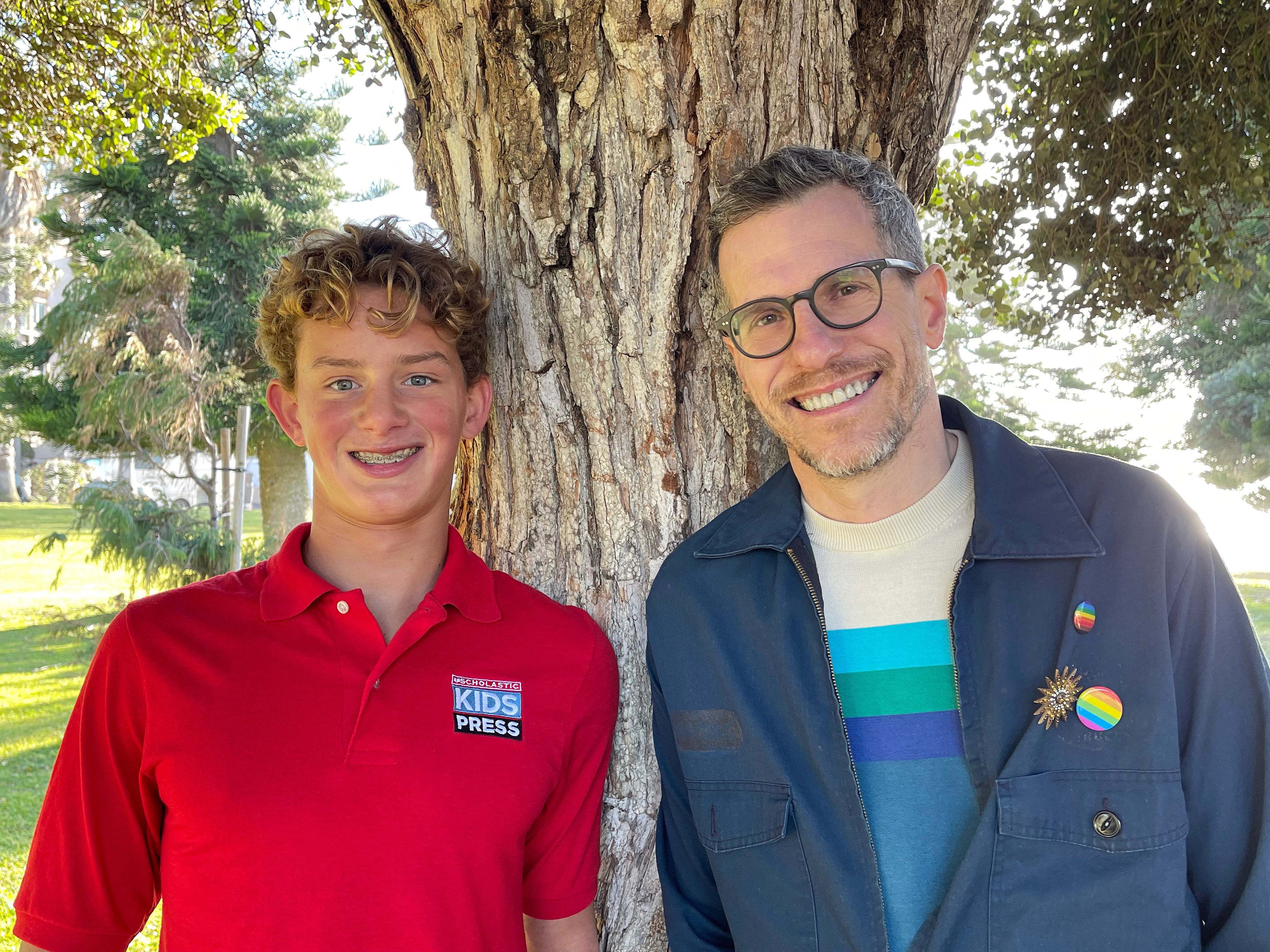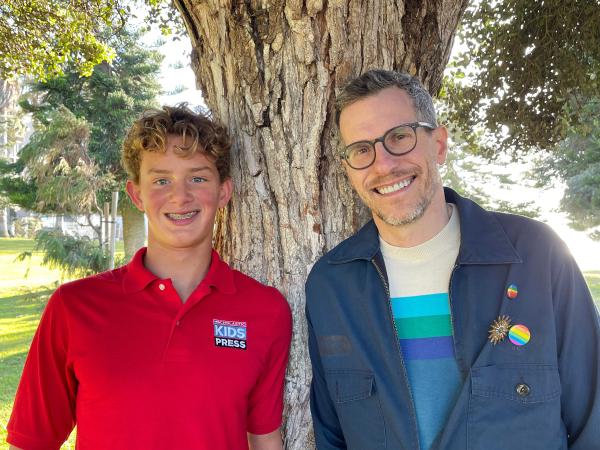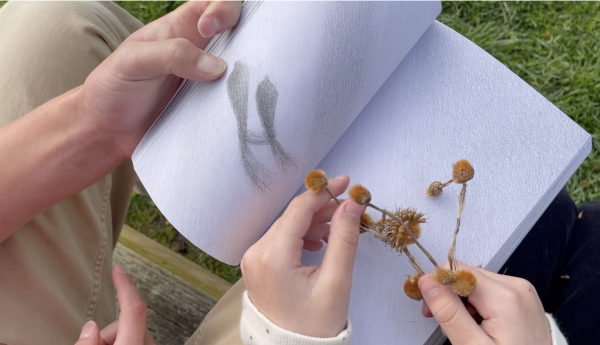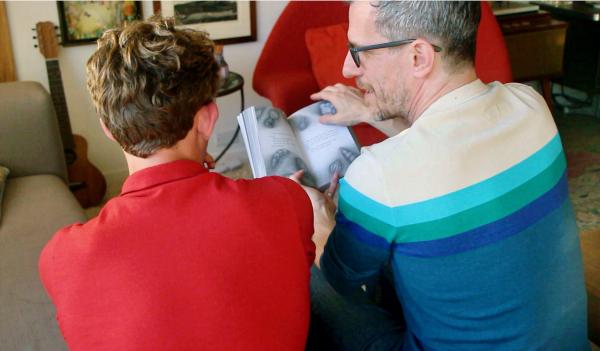KID REPORTERS’ NOTEBOOK
Brian Selznick Talks About Big Tree

Readers can explore the wonders of nature with Big Tree. The new illustrated novel by famed author and illustrator Brian Selznick will be published on April 4 by Scholastic Press.
The story introduces Merwin and Louise, two tiny Sycamore seeds who began life during the Cretaceous Period, when dinosaurs roamed the Earth. After their mother tree releases them, they embark on a dangerous 147-million-year adventure to the modern day.
“While working on Big Tree, I learned that what feels like a long time to us, for nature, isn’t long at all,” Selznick says.
After reading an advance copy, I met with the New York Times best-selling author and illustrator in La Jolla, California, where he has a home. He explained the lessons that nature offers about helping our planet and each other.
“The real seed is that we all can do something to help,” Selznick said. “No matter how small you feel. There's always something you can do.”
Each drawing in Big Tree is 3x5 inches and completed with a pencil under a magnifying glass.
Like most of Selznick's novels, Big Tree is filled with detailed black-and-white illustrations, which took years to complete. Each drawing is 3x5 inches and completed with a pencil under a magnifying glass. The images are made larger and published in a particular way so that the thick books can lie flat, allowing readers to study each detailed pencil stroke.
Here are more highlights from our conversation, which has been edited for length and clarity.
What was your main goal when writing Big Tree?
I wanted to find ways to make real science interesting to readers so that you felt like you were learning about characters, but you were actually, secretly, learning about science and nature.
I read that you and director Steven Spielberg worked together on this project. Is Big Tree going to be a movie?
Big Tree was supposed to be a movie first, so the little seeds, the book itself went on a long journey. Five years ago, Mr. Spielberg called me to write a movie for him that would be about nature from nature’s point of view. I wrote a screenplay, and it was going to be an animated movie. Then the pandemic hit. Everything changed for all of us. I just felt very sad by that point because I really loved the story, the seeds, the world we had created, and what we were trying to say. I asked Mr. Spielberg if I could have permission to turn the screenplay into a book. He said, ‘Yes.” It would be fun to think about it as a movie again, but I’m very happy that it’s a book.

Quade visits with award-winning author and illustrator Brian Selznick in Scripps Park in La Jolla, California.
What research did you do before writing Big Tree?
My real research started at the New York Botanical Garden. I met a person who is a paleobotanist, which means that he studies prehistoric plants. Then I talked to a wonderful park ranger. She walked me through the forest and described how the roots under the soil are connected by the mycelial network, like the fungus and mushrooms that help the trees communicate with each other. [The underground network allows living things to exchange nutrients.] She talked about the way leaves work, the way trees grow, the way trees experience time.
Why did you choose a Sycamore tree?
Sycamore trees are called fossil species, which means they have been around since the time of the dinosaurs. They are familiar to modern trees we see in forests today. The Sycamore tree also makes those kind of seed balls, a little bit like a nursery, like all these kids in there together. In most of my stores, I write about kids who get separated from their parents and find their way in the world. That’s kind of what Sycamore seeds and other seeds do. They must break away from the plant that made them and go find a place to grow.
Are there any fun facts about how you created the seeds Merwin and Louise?
There was an American poet named W.S. Merwin, who lived in Hawaii for a long time and planted the only man-made rainforest. Merwin the character is named after him. Louise is also named after an environmentalist.

In Big Tree, Merwin and Louise, who are tiny Sycamore seeds, go on an epic adventure to save the world.
They go on epic adventures. Which one was your favorite to draw?
It was fun trying to imagine all the different places these two little seeds could go. I wanted them to go underwater. Drawing pictures underwater is so hard [laughs]. Writing the whole scene with King Seaweed was really fun.
What was the most fascinating science you learned while creating Big Tree?
What surprised me the most was the idea that forests are really communities. Trees communicate with each other with a mycelial system underneath the ground that connects everything. It felt like there were interesting parallels with us, because we live in communities, and we try to help each other. Sometimes, there are threats from outside, and we have to figure out ways to survive. Plants are doing the same thing. We’re part of something gigantic. We're part of the world. We're part of a community. And that, to me, was a really important part of Big Tree.

“We’re part of something gigantic,” Selznick tells Quade. “We’re part of the world.”
